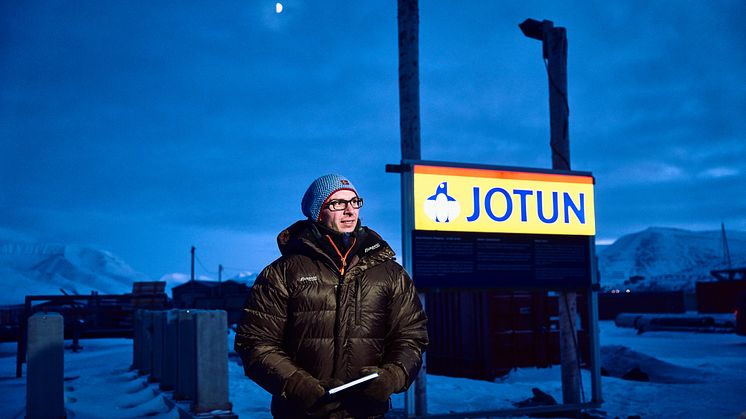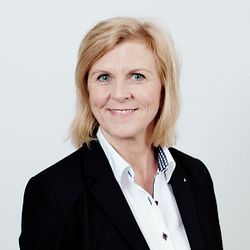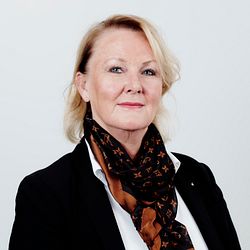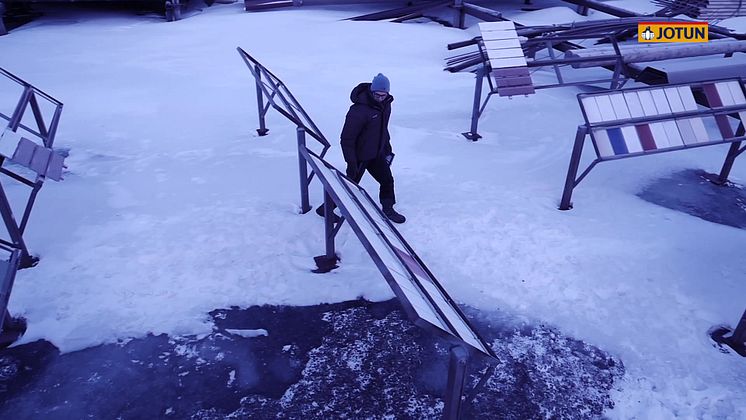
Nyhet -
Groundbreaking testing in the Arctic
With the establishment of a test station on Svalbard, Jotun is the first to carry out testing of products and paint systems in the Arctic region. So far, the test results have been both reassuring and surprising.
Reassuring, because it has been shown that the experience Jotun has gained from the Barents Sea and the Norwegian continental shelf has resulted in products that withstand conditions also in the Arctic regions. Surprising, because the climate is changing and is different from what was believed, with higher temperatures and more humidity.
 Svein Erik Andresen (Global Business Development, Protective Coatings) and Anders Skilbred (R&D Senior Chemist) studying paint samples exposed at the test station.
Svein Erik Andresen (Global Business Development, Protective Coatings) and Anders Skilbred (R&D Senior Chemist) studying paint samples exposed at the test station.
Svalbard is one of the world’s northernmost inhabited areas with its location north of the Arctic Circle, and the climate is characterised by low temperatures all year round, seasonal darkness, midnight sun and long periods of fog, high winds and violent storms.
Just outside Longyearbyen stand Jotun’s test panels, mounted on poles that are hammered eight metres down into the ground. The test station was opened in autumn 2015, in collaboration with Innovation Norway, Svalbard University and Leonard Nilsen og Sønner, Jotun’s local partner at Svalbard.
 The world's only Arctic test station for paints and coatings, located just outside Longyearbyen, Svalbard.
The world's only Arctic test station for paints and coatings, located just outside Longyearbyen, Svalbard.
“Boring is good”
- Our experience from the Barents Sea and the Norwegian Continental Shelf shows that the Arctic is not a myth for us, we are used to these conditions. But prior to this test station we have had no way of documenting this. Findings so far confirm what we believed and hoped, namely that our products perform well in this climate, says Anders Skilbred, senior chemist in Jotun and responsible for the test station at Svalbard.
- And even though that might sound rather boring, in this case “boring is good”. This means that what we have done so far works well, and that our customers can be certain that our products meet expectations, even in the Arctic region.
About 40 different paint systems are now being tested on Svalbard, including products from all segments: protective coatings, powder coatings, decorative paints and marine coatings. In addition, ice-breaker paints are being tested in the Van Mijen Fjord outside Svea, a small mining community about 45 kilometres south of Longyearbyen. The fjord freezes over every winter, and metre-thick ice moves up and down with the tide and wears the paint samples.
 To access Jotun's test station at Svea during winter, one has to ride snow mobiles. When moving outside the settlement of Longyearbyen, Jotun staff is always accompanied by a local guide with firearm, as Svalbard has a large polar bear population.
To access Jotun's test station at Svea during winter, one has to ride snow mobiles. When moving outside the settlement of Longyearbyen, Jotun staff is always accompanied by a local guide with firearm, as Svalbard has a large polar bear population.
- More and more projects are starting up in cold climates, and the industry has limited knowledge on how paint behaves over time in this climate. At the same time, this Arctic and vulnerable climate sets greater demands to us to create sustainable solutions with as little environmental impact as possible, states Svein Erik Andresen, business development manager in Protective Coatings.
Anders Skilbred adds:
- Academic literature has little reference to the Arctic climate, and all testing that we conduct here will provide us with increased knowledge and better products.
Field tests are important
Many products must pass various laboratory tests to be approved. Jotun conducts a number of such laboratory tests, but stresses the importance of supporting the results with tests conducted under real conditions - so-called field tests.
- Laboratory tests are necessary and important, but they must be supported by field tests. To obtain proper results you must be willing to test for 10-15 years. We have a long-term perspective in Jotun, and set aside time and resources for field testing, says Anders Skilbred.
He emphasizes the importance of testing under real conditions, and simplifies it by comparing it to baking a frozen pizza.
- You do not necessarily obtain the same result if you bake a pizza at 2,500 degrees for one minute, as if you bake it at 250 degrees for ten minutes. Field tests provide us with documented experience under real conditions, says Anders.
 Senior Chemist Anders Skilbred on the way to Svea.
Senior Chemist Anders Skilbred on the way to Svea.
The test station on Svalbard also provides us with unique opportunities to test characteristics that are difficult to test in a laboratory.
- Take for example the question of UV radiation. UV lamps are used in the lab, but such lamps usually mean that the temperature also increases. Thus, it can be difficult to know what impact is due to UV radiation, and what is due to the increased temperature. On Svalbard the midnight sun lasts half a year, which gives intensive light around the clock. This gives a great deal of UV radiation, while the temperature is not particularly high. This is an example of how the test station on Svalbard gives us the opportunity to test something that is difficult to achieve elsewhere, Anders explains.
Climate is changing
The corrosion rate, in other words how quickly metal rusts in untreated condition, has never been measured before on Svalbard. With an established test station here, Jotun can contribute with valuable information to the local community on Svalbard.
- The climate is changing, and average temperatures have been higher than normal every month for the last eight years. For example, hunting huts that have stood for a hundred years, are now starting to rot. Untreated metal panels set out about two years ago are already rusting quite heavily, says Anders.
- This obviously sets greater demands to us in Jotun. We must develop even better and more sustainable products and solutions that not only protect assets, but also the environment.
 You can encounter polar bears anywhere in Svalbard all year round.
You can encounter polar bears anywhere in Svalbard all year round.
All photos: Morten Rakke




